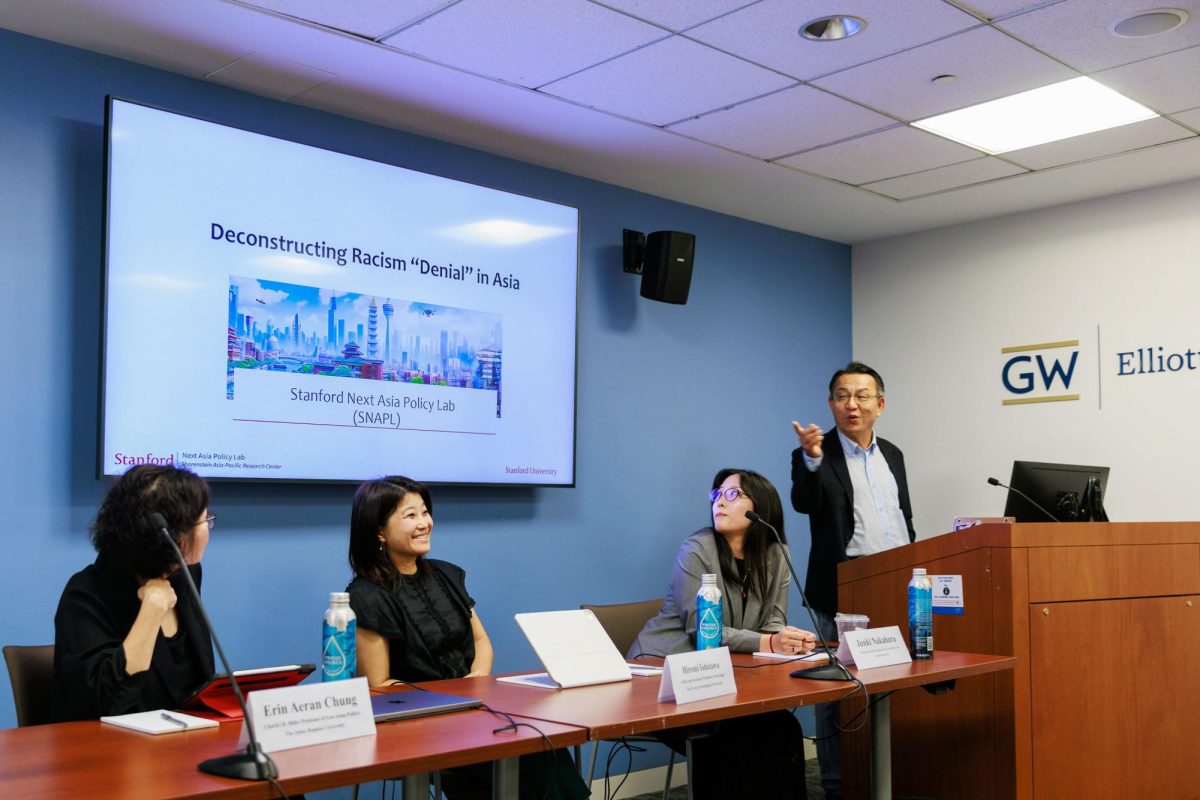Experts in sociology and Asia discussed research investigating the prevalence of racism “denial” in Asian countries at the Elliott School of International Affairs on Tuesday.
Gi-Wook Shin, a professor of sociology at Stanford University, formed a panel with Johns Hopkins University political science professor Erin Aeran Chung and Stanford University postdoctoral fellow Junki Nakahara to discuss research that looks into the root causes of racism “denial” — when an act of racism is not framed as discrimination based on physical characteristics but as issues like border security and immigration — in Asian countries. The event was hosted by the Sigur Center for Asian Studies and moderated by Hiromi Ishizawa, an associate professor of sociology.
Nakahara said the racist narratives they found in their research were rooted in four variations of denial: “no racism,” “no racism yet,” “racism is unfamiliar” and “racism is foreign to their country.” Nakahara said the concept of race or a hierarchical view of race-based prejudices like skin color only arose in Asia after westernization — the influence of the western world on Asia fueled by the industrial revolution and the age of imperialism — in the mid 1850s.
“There’s also this complex mix of pre-colonial, indigenous, social, economic and political stratification,” Nakahara said. “So the typical example would be the caste system, caste stratification in South Asian context on one hand, and on the other hand, the racial, the internalized western concept or Western theory of this racial hierarchy that legitimized this colonizer-
Nakahara said the pre-Westernized concept of race in Asia is made up of “race, ethnicity and nation” because the idea of hierarchical racism — the ranking of races in a society based on perceived characteristics — was brought to Asia through colonialism, mixing with their already existing ideas of ethnicity and nationality.
Nakahara said her research analyzed 16 countries who signed a 1965 United Nations treaty to fight racial discrimination. She said when referencing events that fit the western idea of racism such as the mistreatment of minority groups in Japan or Thailand, the countries did not define it as racism but as border control or counter terrorism.
Nakashara said the reports included three kinds of denial: “literal denial,” “interpretive denial” and “ideological denial.” She defines literal denial as denying the existence of racism in the country, interpretation as denying that it is racism and ideological denial as denying racism exists within their ideological framework.
Ishizawa said the research presents decades of reports and analysis but doesn’t clarify whether the forms of denial changed over years of reporting. She said the data needed to be more thorough with attention to the type of denial that would be more prevalent during different time periods so that readers could better utilize and understand the data.
“Again, it’s a temporal issue as well. Is it more common in the past? More complex in the recent years and simplifying it to complete denial in more recent years?” Ishizawa said.
Chung said there was a need to include a comparative analysis that could add insight into the global patterns of racism denial. Chung said this comparative analysis would bring more depth by adding nonstate actors like nongovernment organizations who bring attention to the emerging societal problems with racism in their respective countries.
Chung said it would be helpful to include analysis of reports from non-Asian countries. She questioned why the researchers chose to study Asia and not a broader or more focused region.
“You know what is the value of examining racism denial in Asia, right?” Chung said. “You know why not just focus on East Asia or South Asia or Southeast Asia or on liberal democracies or developing autocracies.”





